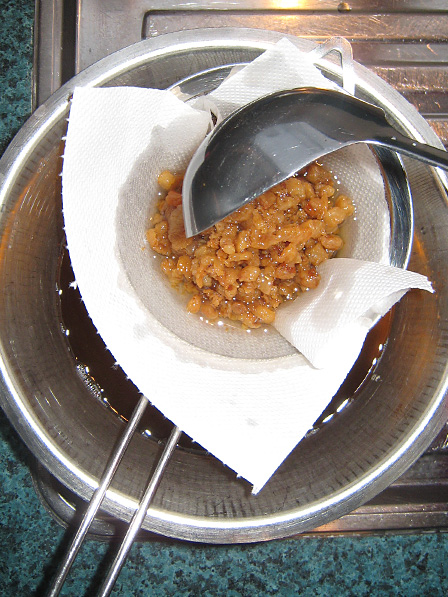I am very happy to say that we have been enjoying some home made cheeses at last! I’ve been making several kinds, but the one I’ve made most often so far is a camembert-style cheese, also known as coulommiers. That’s the kind of cheese I’m going to write about today. I thought I’d share a detailed recipe in case anyone else is curious or wants to have a go at making some.
 Home made camembert cheese
Home made camembert cheese
I have made this kind of cheese fairly often because it requires less milk, and is less labour-intensive than most of the other kinds of cheese I’ve been making. It only needs to ripen for one to two weeks before eating, and we find the result delicious!
Please don’t be put off by the long list of equipment below. You’ll probably most of the stuff in your kitchen already, and the rest can be obtained very cheaply. In New Zealand, starters and other cheese-making supplies are available online from “Curds and Whey” or “Cottage Crafts.”
Equipment needed:
*Gas or electric element
*Tea towel (good to have tea towels that you wash separately and keep solely for cheese making)
*Stainless steel double boiler (doesn’t have to be good quality, non copper bottoms are fine. Be inventive with combinations of pots and buckets.)
*Medicine measuring cup (available from pharmacy)
*Stainless steel skimmer or slotted spoon
*Whisk
*Glass thermometer (Sold by Kowhai Cheese, Curds and Whey, or kitchen hardware shops sell candy thermometers)
*Bucket (for putting sterilised water into)
*Cheese mat (you can use shade cloth or sushi mats as cheaper options)
*Molds (You can poke drainage holes in tupperware containers or sections of pipe for these. I’ve also heard of people drilling holes in sections cut from large stalks of bamboo. I’d love to try making some of these!)
*Draining rack
*Wine fridge, ice packs and cooler box, or cellar for keeping cheese at correct temperature
*Steriliser tablets (baby bottle steriliser tablets) optional
Ingredients:
3 litres whole milk (I use fresh raw milk)
3 ml rennet diluted in 3ml boiled and cooled water (I use calf rennet)
A few grains of Flora Danica starter culture
A very tiny amount of Penicillum Candidum starter culture
Salt (not iodised)
Method:
Day One:
Before you start: Ensure all equipment is sterile. Most home cheese making failures are caused by unsterile equipment or mishandling of the milk. Either soak equipment in boiling water for 5 minutes or in hot water that has been treated with steriliser tablets. I half fill a 9 litre bucket with hot water and add a steriliser tablet. All equipment is treated with this liquid before it touches the milk or cheese.
 Milk in water bath
Milk in water bath
 Skimming out layers of curd
Skimming out layers of curd
1. In a water bath, heat the milk to 31 degrees C. Stir gently with whisk to ensure even heating
2. Sprinkle the starter cultures onto the surface of the milk and stir in thoroughly.
3. Add diluted rennet to the milk and stir gently but thoroughly for one or two minutes.
4. Cover with a tea towel and leave for about half an hour for the curd to set.
5. Place mould(s) on cheese mat.
6. Using a stainless steel skimmer or slotted spoon, skim thin layers of curd from the pot and gently lower them into the mould. Continue until the mould is filled to the top. The thinner the layers of curd, the faster the cheese will drain.
7. Cover with a tea towel and leave to drain overnight.
Day 2:
 Curd has reduced
Curd has reduced
 Ready to age
Ready to age
1. When the curd has reduced to about half of its original size, it should be firm enough to turn out onto a second cheese mat.
2. Sprinkle salt on all surfaces of the cheese.
3. Age the cheese on a rack in a cool place (about 45 degrees F) at about 80-90% humidity, turning every couple of days.
4. Once it is ready to eat, wrap the cheese in wax paper or cheese wrap and keep it in the fridge.
For aging the cheese, it would be very nice to have a wine fridge or cellar at the right temperature. I don’t, so here’s what I do: put the cheeses on a rack in an ice chest (chilly bin) with a couple of ice packs. I use 2 ice packs for a large ice chest, and change one each morning and one each evening. (I need to have 3 ice packs to do this, so that one can be in the freezer.) So far, this method seems to be working out fine.
This cheese can be eaten after about a week, at which time it will have a milder taste and less white mould. For a stronger cheese covered in a thick growth of white mould, age for about 2 weeks.
We love to eat this cheese on sourdough crackers or bread. Kevin prefers to eat it after about one week, while I prefer to have it aged longer. Needless to say, Owen is very fond of some of our home made cheeses as well. I’ve also been experimenting with feta (cow’s milk feta), soft cheese and gouda, so will be writing about those in due course.
 Owen sits on his sheep pelt and devours the raw milk cheese
Owen sits on his sheep pelt and devours the raw milk cheese
Sources: This cheese recipe is based on the one in Ricki Carroll’s “Home Cheese Making,” plus another recipe that a friend passed on to me. I think the recipe from my friend may be from Katherine Mowbray’s book, which you can buy from her “Kowhai Cheese” website. (Katherine Mowbray is famous in New Zealand cheese-making circles for her fabulous cheese-making classes.) The equipment list and notes on hygiene come from my friend and cheese-making teacher, Natalie.












